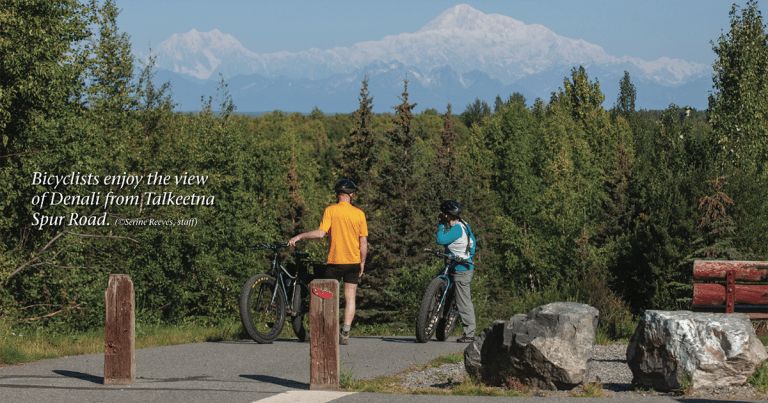Bicyclists enjoy the view of Denali from Talkeetna Spur Road. (Photo by Serine Reeves)
Road conditions vary throughout Alaska from paved highways to unimproved gravel roads. The summer bicycle routes discussed here are on Alaska’s paved highways. These major routes generally have good shoulders. But bicyclists share the highways with vehicles. Be alert! One advantage of Alaska touring in summer are the long daylight hours.
What to take
Bike shops are few and likely only in larger communities so planning is essential. Bring the tools (and skills) necessary to repair your bike as well as extra gear and brake cables, inner tubes, patch kit and pump. Pack wind/waterproof gear, layers for fluctuating temperatures, water (and a method to purify water), freeze-dried/lightweight food, cook stove, camera, tent or bivy sack, sleeping pad and sleeping bag in waterproof panniers or packs. We recommend saddlebag-style bicycle packs over a back wheel with fender. Remember to keep bear spray and bug spray readily available while you ride, just in case you need it. Perhaps most important of all, wear reflective/high visibility gear and outfit your bicycle with lighting to make certain that traffic will see you as you ride.
Suggested Routes
Anchorage to Denali National Park (237 miles) or Fairbanks (363 miles) via the Parks Highway. Take the Alaska Railroad (www.alaskarailroad.com) or Valley Transit bus (www.valleytransitak.org) from Anchorage to Wasilla, where you will start peddling north on the Parks Highway to Denali National Park or Fairbanks. Services are available in Wasilla at Milepost 42, and then approximately every 30 to 50 miles to Fairbanks. Broad Pass is the highest point at 2,400 ft. and the route is largely flat with good shoulders. Milepost 237 is the entrance to Denali National Park and Preserve. Don’t miss your chance to explore the park. Campgrounds and all services may be found in the park vicinity. If you plan to camp in the park, make reservations. If you continue on to Fair- banks it is another 125 miles with small communities along the way, including Healy at Milepost 249 and Nenana at Milepost 304 (58 miles outside of Fairbanks).
Return to Anchorage via the Alaska Rail- road from either Denali National Park or from Fairbanks.
Anchorage to Valdez Loop (304 miles). Take Valley Transit bus (www.val- leytransitak.org) from Anchorage to the Trunk Road Park & Ride, where you will peddle north on Trunk Road 2.7 miles to the Palmer-Wasilla Highway. Then take the Palmer-Wasilla Highway 3.8 miles east to downtown Palmer. From downtown Palmer head northeast on the Glenn Highway. This route becomes challenging at Milepost 66, as the next 25 miles eastbound include narrow, winding road, few turnouts, and 7 percent grades. If possible, do this early in the day when there is less traffic sharing the road. There are several lodging and camping locations along the way to get water, a meal, or spend the night, but the next community is Glennallen at Milepost 189. From Glennallen, go south 115 miles on the Richardson Highway to Valdez. Tonsina River Lodge is en route, 36 miles south of Glennallen, with food, lodging and tenting. The remaining 79 miles to Valdez include a 20-mile climb up Thompson Pass followed by 35 miles of mostly downhill into Valdez (all services).
From Valdez, take the Alaska Marine Highway ferry system across Prince William Sound to Whittier. If you and your bike can’t hitch a ride through the tunnel at Whittier, you’ll have to bus or take the train back to Anchorage; bikes are not allowed in the tunnel.



Comments are closed.